It’s Warm and Easy in Tbilisi (Re-post from Feb 2012)
I started A Traveler’s Tale in July 2011. As a new blogger in WordPress, not too many knew about this site yet and I was still struggling to understand how to best position this blog. Back then, some of my very first posts had very few, even zero, reactions. And then, in late 2011 and early 2012, I had a great opportunity to visit the country of Georgia in the Caucasus region. It was a dream come true for me. Georgia is a photographer’s heaven and my photos of the place immediately attracted a lot of traffic and A Traveler’s Tale gained some momentum. Even so, many of those who just recently followed this blog missed the wonderful series about that beautiful, friendly country in the Caucasus and I think they missed a lot. And so I decided to re-post some of my most memorable articles about Georgia, starting with of course its enchanting capital, Tbilisi, to be followed by other exciting sites in the coming weeks as I am preparing my portfolio for yet another exciting country. Have fun!
The Country
Georgia’s location in the Caucasus region is somewhat like a link between Eastern Europe and Western Asia. To its west is the Black Sea and its neighbors include Russia to the north; Turkey and Armenia to the south; and Azerbaijan to the east.
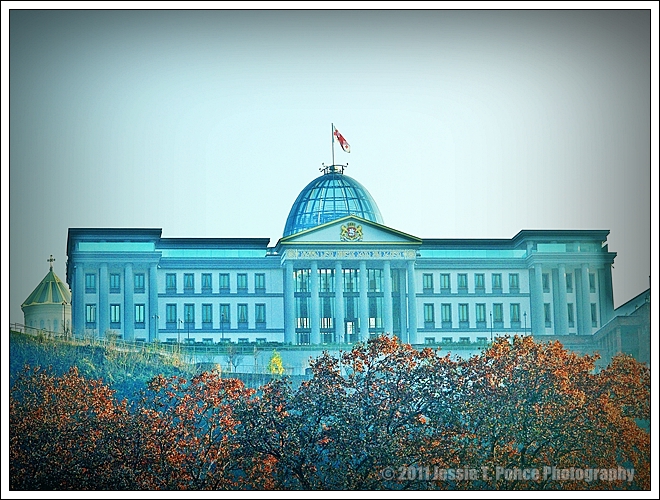
The Presidential Palace glows in morning sunlight over Mtkvari River and the Old Tbilisi section of the capital
According to scholars, Georgia’s history can be traced back to the ancient kingdoms of Colchis and Iberia. It was one of the first countries to adopt Christianity in the 4th century; it reached the peak of its political and economic strength during the reign of King David and Queen Tamar in the 11th and 12th centuries; was annexed by the Russian Empire at the beginning of the 19th century; gained a brief period of independence; was annexed by the Soviet Red Army in 1921; then was incorporated into the Soviet Union in 1922 until the breakup of the Soviet Union and Georgia’s declaration of independence in 1991.
Some notable historians claim that Georgians are so called Georgian because they especially revere Saint George who appears in most national symbols. A statue of Saint George dominates the Freedom Square and in January 2004 the country adopted the five-cross flag, featuring the Saint George’s Cross. It has been argued that the flag was used in Georgia from the 5th century throughout the Middle Ages. Present day Georgia is a democratic semi-presidential republic.
A City of Warm Springs
It was a crisp 14 degrees Celsius – a good shift from the 32 degrees of the tropics – when I got out of the terminal at Tbilisi International Airport. As we drove on the George W. Bush Avenue towards the city, I can already sense the richness of Georgian history and, within the next few days, immediately felt warmth from the friendliness and hospitality Georgian people are known for.
Incidentally, Tblisi also literally means “warm spring”. According to legend, the present-day territory of Tbilisi was once covered by forests and King Vakhtang I Gorgasali went hunting in these woods with a falcon. The King’s falcon was trying to catch a pheasant during the hunt when both birds fell into a nearby hot spring. King Vakhtang became so impressed when both birds got cooked in the hot springs that he decided to cut down the forest and
build a city on the location. The name ‘Tbili’ or ‘Tbilisi’ (‘warm location’) was therefore given to the city because of the area’s numerous sulfuric hot springs that came out of the ground.
At present, several establishments offer sulfur baths in the ancient Bath district several hundred meters from the Metekhi Church. The dome-shaped brick structures with sulfuric steam oozing out from dome-tips are unmistakable. I entered one of these baths with some Georgian friends one night but was I was not ready to take a dip in a sulfuric pool yet. Maybe next time.
Center of Georgian Culture and Religion
Tbilisi has often been a point of contention between various rival powers and empires because of its strategic location at the crossroads between Europe and Asia, along the historic Silk Road routes. The history of the city can be seen by its architecture, where the “Haussmannized“ Rustaveli Avenue and downtown are blended with the narrower streets of the medieval Narikala district. The city is also emerging as an important transit route for global energy and trade projects and a significant industrial, social and cultural center in the Caucasus.
It is easy to daydream about being a king or a prince, a queen or a princess in Georgia where medieval castles, churches and monasteries seem to compete for attention in the Georgian landscape. The 4th century Narikala fortress, towers on a hill above Tbilisi. Standing along its wall could immediately give a sense of the power that its occupants once held. Almost the whole of Tbilisi can be viewed from this fortress, especially its most dominant landmarks including the Metekhi where a statue of King Vakhtang I Gorgasali stands guard over a bridge beside a beautifully placed church. The imposing Tbilisi Sameba Cathedral, the largest religious building in Georgia and the Caucasus, is very visible from this vantage point together with the presidential palace across the river. On the other side of town, the statue of Saint George on a horse in the middle of Freedom Square is also visible as it is poised to gallop towards Rustaveli Avenue, the primary and busiest street in Tbilisi. The Mtatsminda (Holy Mountain); a necropolis where some of the most prominent writers, artists, scholars, and national heroes of Georgia are buried; stand adjacent to the fortress. The modern structures of a leisure park on the mountain are now providing contrast to the medieval structures of the Narikala.
The abundance of churches, many of them ancient, is another characteristic Georgia is famous for (my series on medieval Georgian churches and monasteries here). This is also consistent with Tbilisi’s reputation for religious tolerance. In the city’s Old Town, a mosque, synagogue, and Eastern and Oriental Orthodox Churches can all be found within less than 500 metres from each other.

A uniquely designed wedding place (now a private property) catches attention in another part of the city
Georgians are also well-known for their friendliness and hospitality and I personally experienced this during my 2 visits. But closely watching over Tbilisi on one edge of the Narikala is the ‘Mother of Georgia’, a colossal statue of a lady holding a sword on one hand and a bowl of wine on the other. The wine symbolizes Georgia’s hospitality towards those who come as friends while the sword symbolizes the country’s readiness to quell those who come as enemies.
A River Runs Through It

The statue of King Gorgasali guards an old bridge over Mtkvari. A modern footbridge can be seen in the distance.
The scenic Mtkvari River cuts across Tblisi, adding more colour to its already picturesque landscape. I struggled for more than a week to capture its scenery as I passed by its banks to and from work but my driver, who seemed to be always preoccupied with getting me to my destination quickly, seldom gave me a chance to snap a good photo. So one sunny morning I decided to take a cab to the Old Tbilisi area and walked the rest of the way to the office. It was still very early but there were already some activities by the riverbank; people wanting to catch the early bus to work, retirees walking their dog, men with their fishing gear hoping to try their luck in the river, and individuals wanting a morning relaxation by the riverbank.
I greatly savoured the scenic riverside view together with the fresh morning breeze. The Presidential Palace exuded refreshed power under the morning sun. The Metekhi church and King Gorgasali’s statue gloriously remained impressive in real life as they were in pictures. The old bridges, joined by an ultra modern pedestrian walkway, magnificently cast their reflections on the calm waters. The traditional balconies, a distinct architectural feature I greatly enjoyed (My series on Georgian balconies here), insatiably viewed the river from above the cliffs. The decision to walk along the banks was more than worth the effort. It was a treasure trove of lovely pictures as I expected.
City of Lights
All the significant landmarks of Tbilisi remain visible and become even grander at night when the lights are turned on. The Presidential Palace dazzles with its white lights, the Sameba Cathedral and all other smaller churches look heavenly as gold and yellow lights bounce from their walls and arches. The Narikala fortress glows and dominates the night lights of the city below. Even the banks and cliffs of Mtkvari River throw dreamy reflections into the water with blue lights flooding their surface while the Peace Bridge seems to breathe in luminous blue.
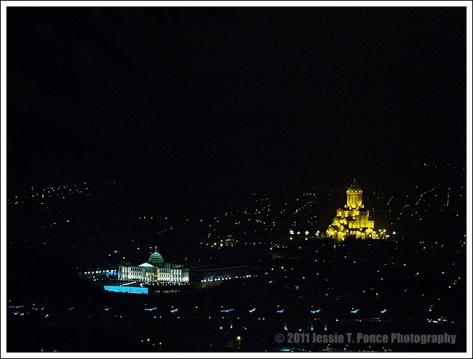
Two Symbols: The Presidential Palace (foreground) and the Sameba Cathedral (background) symbolize Georgia’s young independence and old religious values

Two Churches: The Sameba Cathedral (background), biggest in the region; and the ancient Metekhi (foreground), one of the oldest
At the town center, The Saint George Statue at Freedom Square gets propped up by a cone of white lights and Rustaveli Avenue gets covered by a canopy of yellow and green lights at night.
On Mtatsminda, the neon lights of the leisure park throw delirious swirls of red, green, yellow and blue as if wanting to hypnotize the whole city. And the old traditional balconies of Tbilisi come alive; their intricate details get emphasized as shades of various colors illuminate their corners.
I felt transported to another dimension as I gazed through my lens and took photos (with some difficulty without a tripod for the camera) while Georgian friends, Amiko and Natia, who drove and guided me around the city (after a daytime tour to Kakheti — another story) led the tour and answered all my endless questions about Georgia and Tbilisi.
Winds of Change
In a busy intersection in Tblisi stands a McDonalds, a subtle symbol of Western influence, but the design of its building, while it tries to blend with the surrounding architecture, totally changes my mental image of a yellow-dominated McDonald’s facade.
Such contrasts are not uncommon in Tblisi. The medieval Narikala fortress, for example, is paired by a modern leisure park at the Mtatsminda Mountain while both have important historical value. On Mtkvari River, the ultra modern design of the pedestrian bridge delicately connects two of the oldest sections of the city. These stark contrasts can be discomforting to some Georgians but I found them symbolic of Georgia’s struggle to preserve its treasured past and, at the same time, embrace the conveniences of the future. The trick is in striking the balance between the two and, in my opinion, Tblisi has done well in this aspect. So far.
Related articles
- Mirrored 1 (travellingartist.wordpress.com)
- Mirrored 2 (travellingartist.wordpress.com)
- Mirrored 3 (travellingartist.wordpress.com)
- The Metekhi Church in Tbilisi (travellingartist.wordpress.com)
- The Balcony by Charles Baudelaire (travellingartist.wordpress.com)
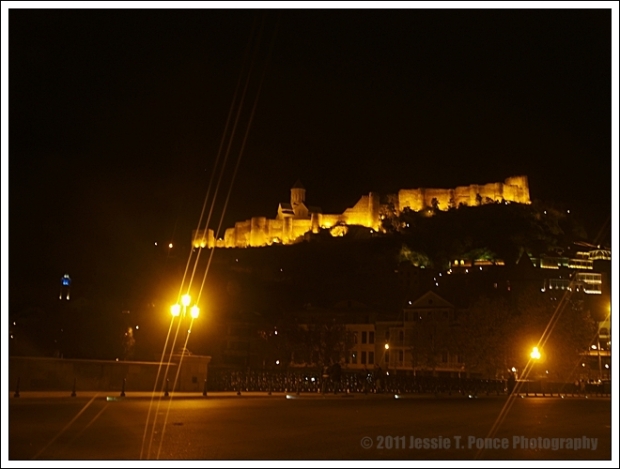
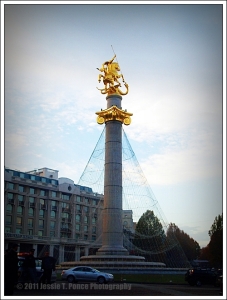
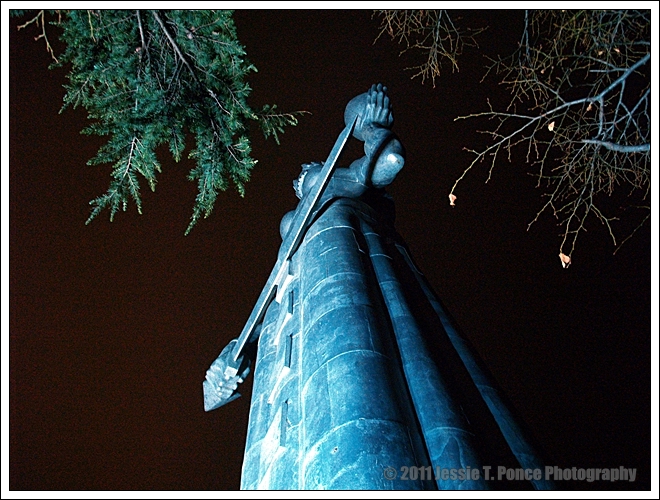
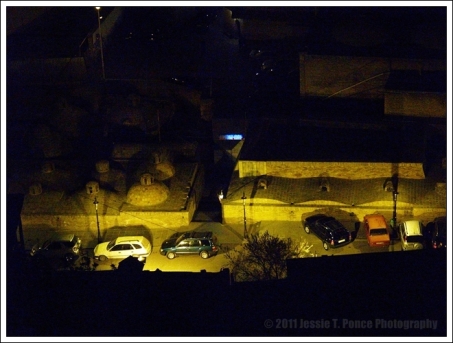
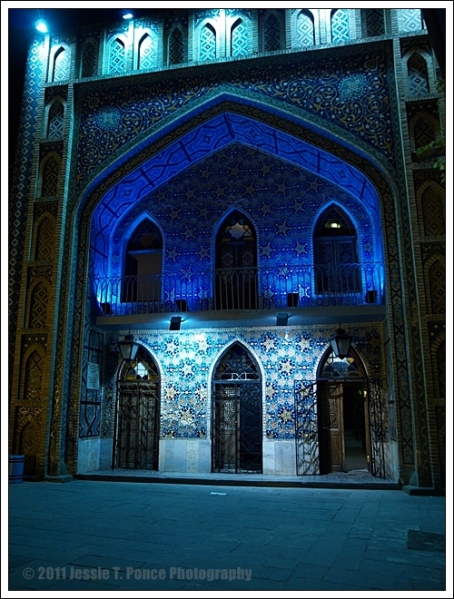
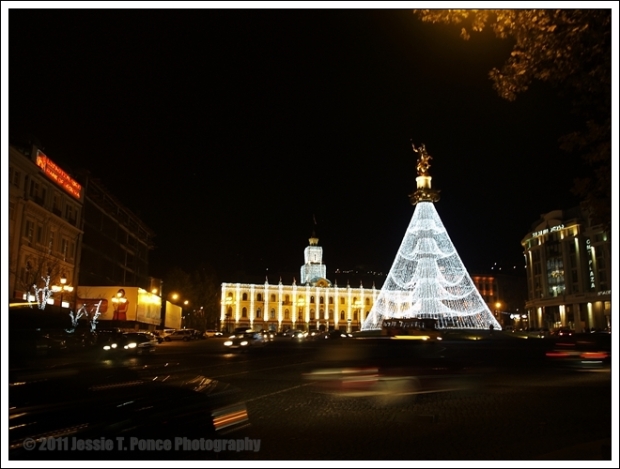

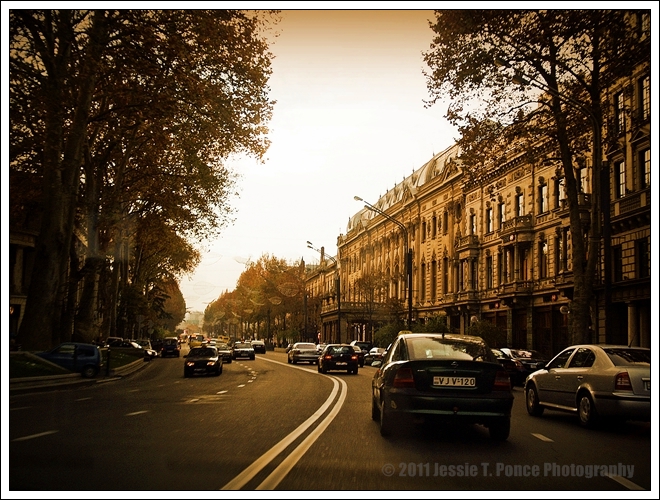
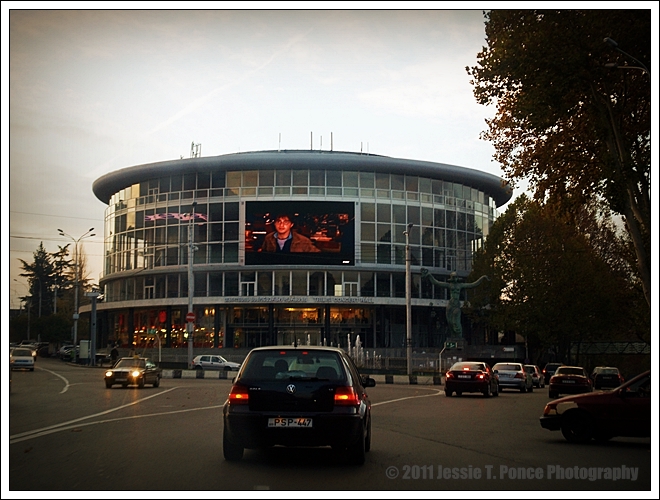
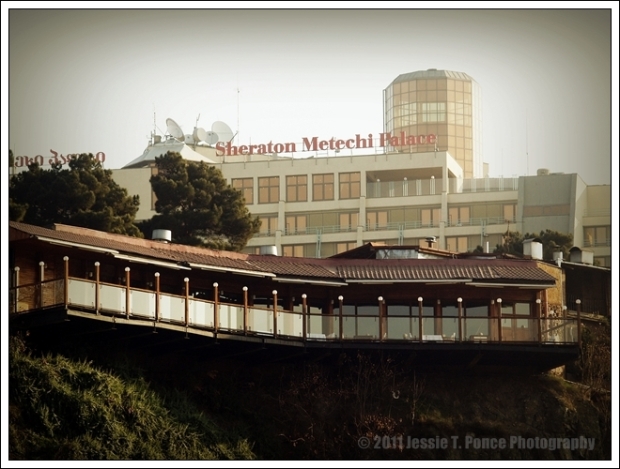
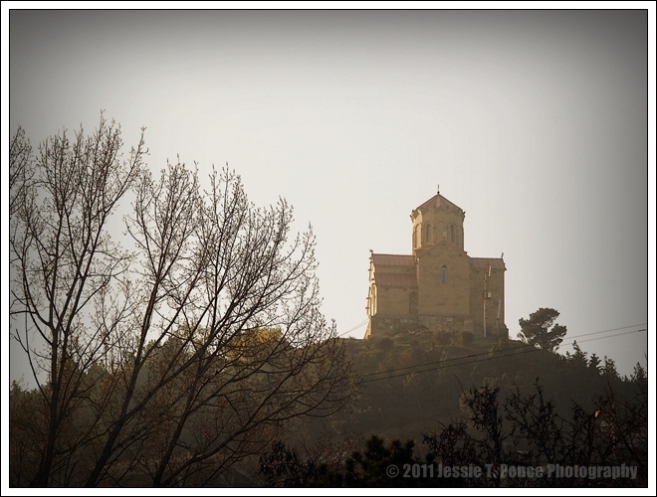
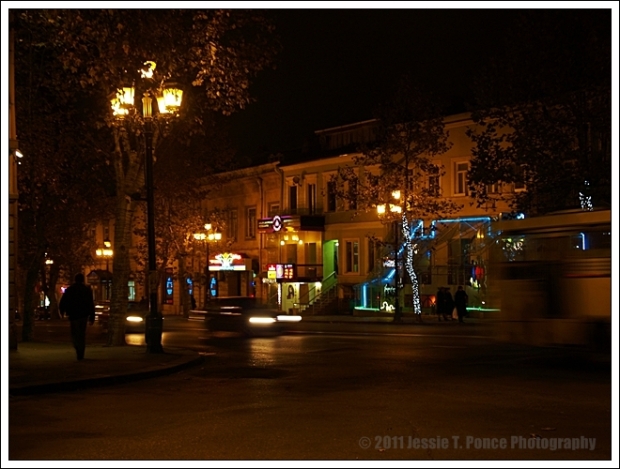
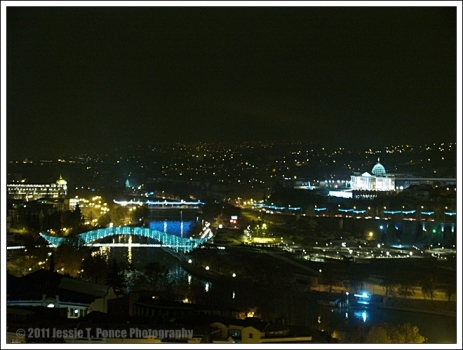
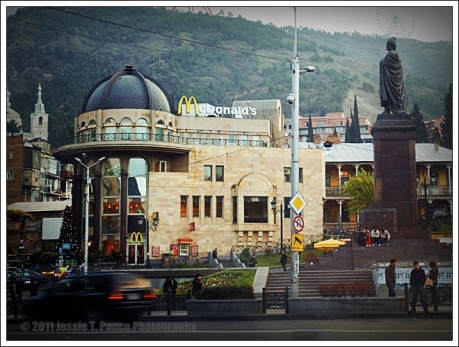
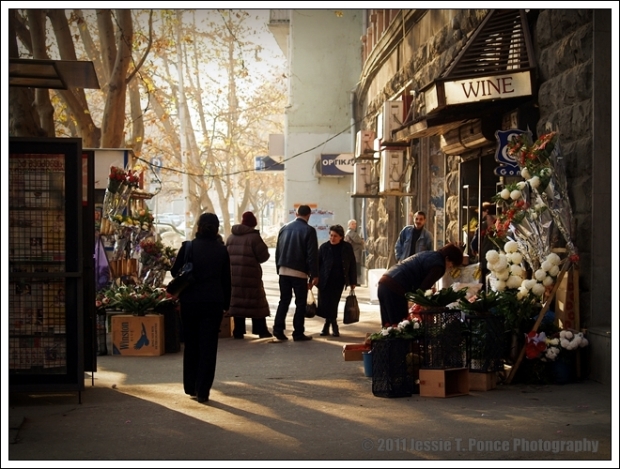










Holy crap. Very nice write-up; makes me want to go visit. Rustaveli avenue at night looks intriguing. Are those neon leaves, or some sort of projection on walls? I could not tell, but they look neat.
Very nice post. Very nice photos. Very nice everything.
LikeLike
Yes, disperser, those are neon leaves. Thank you very much!
LikeLike
Awesome post! I would love to hear some of your feedback!
LikeLike
Thanks.
LikeLike
I forget what it is you do that takes you to all these amazing places.
LikeLike
I’m in international humanitarian/development aid, Lilly, with photography on the side 🙂
LikeLiked by 1 person
Jessie, How did those sulphur baths smell?! Love your shots and enjoyed reading about a place I have little knowledge of. Thanks! ~Kyle
LikeLike
Hi, Kyle. I didn’t notice any particular smell when I entered one of these baths. Maybe the water would have some smell but didn’t get to try it. Thanks for visiting.
LikeLike
Incredible photographs
LikeLike
Thanks, Sandra.
LikeLike
Wonderful photographs and write-up. But I’m curious, why is there a George W. Bush Avenue in Tblisi?
LikeLike
That was one of my big questions too, bluelyon. Apparently, the road connecting Tbilisi to the airport was named after the US president when he visited Georgia. I would have other ideas for the name if I were the Georgian president but that’s none of my business. 🙂 See the photo here: https://travellingartist.wordpress.com/2011/08/03/still-life-random-objects-2/
Thanks for your kind comment….
LikeLike
Beautiful photos – I like the sepia street shot and the morning street scene, especially. Haussmannized – no wonder it reminded me of Paris!
LikeLike
Thank you, Lois. Yep, some semblance to Paris. There’s also a French area of some sort which I did not get to visit. Thanks for visiting.
LikeLike
fascinating post, I love to hear all about places I have never been. I think you should try the sulpher baths, I have been in a hot spring and its wonderful. I love the architecture and especially McDonalds.
LikeLike
I don’t know but somehow I didn’t find the sulfur baths too inviting. If it was in the woods, I would jumped into it without question. 🙂 Yes, I find the McDonald’s structure interesting as well. Thanks a lot, Maggie.
LikeLike
Great photos and a genuinely beautiful country….
LikeLike
Thanks you very much, Russell. (Had to leave out the rest of your comment. I hope it’s okay.) 🙂
LikeLike
No problem 🙂
LikeLike
Great write up and superb photos. I am very pleased that you enjoyed your visit to Georgia. Next time you come you must visit the colorful outdoor markets – it’s a photographers dream! I have some photos of the markets in one of the albums on my Facebook page. My blog also has a category called Ladies Who Sell Things, which tries to capture the incredible entrepreneurial spirit and inventiveness of street traders.
LikeLike
Thanks, Bassa. Will check out (and photograph) more places next time. Regards.
LikeLike
This is a very impressive introduction to a fascinating country. I have met many people from Georgia in my life, and never gotten such a picture of the beauties of that country, not to speak of the cultural and historical background.
LikeLike
Thank you very much, ShimonZ. I appreciate your visit and your kind comment.
LikeLike
This is a link to one of my posts about the pavement sellers of Tbilisi: https://bassasblog.wordpress.com/2011/09/17/they-must-be-nuts/
LikeLike
Thanks again….
LikeLike
You are very welcome.
LikeLike
I love your travels, you go to most unusual places! Great pictures, as always!
LikeLike
The ‘unusual’ places is where my work is, Kristina. Thanks for your compliment on the photos.
LikeLike
Thanks for stopping by my blog–I’m a humbled you like life Project 365 offerings as I am such an amateur. I love all your entries on Georgia as that was the country my scout troop covered for World Thinking Day about 5 years ago. Beautiful!
LikeLike
No need to be too modest, snipewife. As far as I’m concerned, we’re all disciples of art here. 🙂 Good to know about your scout troop’s coverage of Georgia. You must know a lot more about the country. Thanks for the return visit.
LikeLike
Fascinating blog and incredible photography!
LikeLike
Thank you.
LikeLike
Enjoy reading about other cultures.Very good.
LikeLike
Thank you, ken.
LikeLike
Fascinating stuff. One gets a mental picture of a place when all you know is a name and a dot on a map. You’ve just blown my mental picture right out of the water. Thank you for such an informative piece.
LikeLike
Encouraging feedback, Stevie. Glad to hear about how my post has affected the reader. Thank you very much.
LikeLike
Pingback: Mirrored 4 | A Traveller's Tale
Pingback: Medieval Mtskheta | A Traveller's Tale
Your pictures are great…but I always go away from your blog feeling like I’ve learned something new as well.
Thanks!
LikeLike
Pingback: By the River Mtkvari 1 | A Traveller's Tale
So much here! The presidential palace reminds me of the Reichstag in Berlin (probably just the dome). All shots are terrific as is your commentary on the city/country as well.
G Bush street — well, I wouldn’t take just any old ‘George’ if I were them, but then again, I’m not. 🙂
The old, the new, the McDonald’s facade — all just great. No matter where we live, we should learn (by visit if possible) about other cultures and countries. I help run an international cinema program at our university to help our students do just that. Not quite the same as going there, but even a ‘window’ helps.
LikeLike
Pingback: By the River Mtkvari 2 | A Traveller's Tale
Pingback: Holy Khinkali! | A Traveller's Tale
Pingback: Road to Kakheti 1: Above the Clouds at Gombori | A Traveller's Tale
Pingback: By the River Mtkvari 4 | A Traveller's Tale
Pingback: By the River Mtkvari 5 | A Traveller's Tale
Pingback: Page not found | A Traveller's Tale
Pingback: The Metekhi Church in Tbilisi | A Traveller's Tale
Pingback: Foggy Sighnaghi | A Traveller's Tale
Pingback: Oh no, another teaser! | A Traveller's Tale
Pingback: Batumi 1: Break of Day | A Traveller's Tale
Pingback: By the River Mtkvari 3 « A Traveller's Tale
Pingback: Images of Georgia: Three Cities « A Traveller's Tale
Loved your photos of Tbilisi. I’ve never been to Georgia, but know it is a magical place. Too bad the relations with Russia are strained.
LikeLike
Thank you!
LikeLike
Only this morning I found out about the failed assassination of George W. Bush at the Freedom Square during his visit to the country. I can’t imagine how different the world would have become if that happened. Tbilisi would be a new Sarajevo I guess, which saw the event that culminated into the WWI. I’m glad Freedom Square is now a nice place with lights and the statue of Saint George without having to witness a potentially catastrophic event.
LikeLike
Yes, I heard about it but not many Georgians would like to talk about it. A scary thought indeed especially because of Georgia’s on-going tension with Russia. Glad it didn’t happen and yes, the statue of Saint George prevails at Freedom Square. Thanks a lot for leaving a trail of comments on my posts.
LikeLike
Pingback: 2013: Lake Sebu Revisited | A Traveller's Tale
Great blog! I can’t wait to visit Georgia, it looks like such a fascinating country. Thanks for the information.
LikeLike
thanks for reposting this. it’s only now that i chanced upon it. your photos took us to an amazing place.
LikeLike
Thanks. Tbilisi is a personal favorite. 🙂
LikeLike
Pingback: It’s Warm and Easy in Tbilisi (Re-post from Feb 2012) | ofRainbowsandButterflies
This is my most favorite post in your blog. I actually shared it on my Facebook page (that with McDo photo). Thanks for sharing Mr. Ponce 🙂
LikeLiked by 1 person
Hey, Mavic. I’m actually flattered, quite embarrassed that I haven’t even checked your blog before. Thanks for letting me know that you’re there and for sharing this post. Cheers!
LikeLiked by 1 person
It’s alright 🙂 I hope you’ll have more time to write because I could learn from your writing style. For now, I’ll learn about the tales you want to tell through your compelling photographs. I can still remember your photos of Lake Sebu and your blog about the island that is at the brink of extinction.
LikeLiked by 1 person
Wow! Those articles were posted some years ago. You must have been following this blog for sometime now — Thanks! I do hope you’re learning something from me. 🙂 I’m presently working on a series about Myanmar while on a short break from my travels — I hope you’ll like it.
Btw, I just saw a Georgian friend post my McDo – Tbilisi photo on her timeline today. I wonder if it was from your FB post or was pulled out from this article.
LikeLike
Yep, since I’ve read your Tbilisi post I’ve got hooked. There’s something in your writing style that I love. 🙂 Re McDo pic on FB, I’m not sure but I would’ve been notified if someone shared it. Maybe it’s the latter. Btw, glad you’ve got the time to work on a new subject. I know it will be another “hit” hehe Cheers!
LikeLike
great blog!
LikeLiked by 1 person
Thanks!
LikeLiked by 1 person